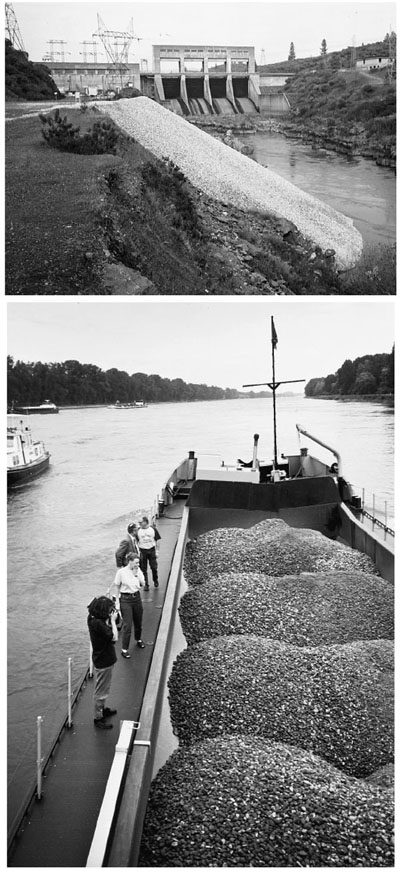Add sediments
Contents
- 1 Add sediments
- 1.1 General description
- 1.2 Applicability
- 1.3 Expected effect of measure on (including literature citations):
- 1.4 Temporal and spatial response
- 1.5 Pressures that can be addressed by this measure
- 1.6 Cost-efficiency
- 1.7 Case studies where this measure has been applied
- 1.8 Useful references
- 1.9 Other relevant information
Add sediments
Add sediments06. In-channel structure and substrate improvement
General description
The incision of the riverbeds has been widely observed on many streams of mobile bed. Incised channels occur when stream power exceeds the channel bed’s resistance, or when sediment output exceeds the sediment input to the reach. Human alterations causing channel incision are upstream dams, straightening, bank revetment, construction of levees, large wood removal, changes in land use, etc.
As a result, high flows erode gravel and often cause the formation of a paved or armoured channel-bed. Medium sized gravel suitable for spawning of anadromous fish is not replenished by upstream supply or bank erosion and becomes scarce or is completely absent as well as erosional and depositional features that results from natural sediment dynamics like pools and riffles. Moreover, armouring of the channel-bed decreases the surface-subsurface water exchange and the interstitial spaces available for colonization by invertebrates.
The most efficient long-term solution is to restore a natural flow and sediment regime, e.g. by decreasing urban runoff, restoring river continuity for sediment transport or allowing natural channel dynamics and bank erosion.
If options for river restoration are limited, gravel augmentation (or ‘‘replenishment’’), the artificial supply of bed load–sized sediments to channels, is an appropriate mitigation measure to partially compensate for a sediment deficit. (Kondolf, 1994, 1997, Sklar et al. 2009).
In general, there are two different ways to add sediment:
- gravel placement at several locations, shaping bars or riffles to provide direct habitat benefits,
- gravel injection to provide sediment which is eroded and transported downstream to decrease the sediment deficit downstream of dams (called “passive gravel augmentation” by Bunte 2004).
Only the latter is considered in this fact-sheet. Restoration projects which focus on the direct creation of spawning habitat by one-time gravel additions in river reaches with low erosion potential are described in the fact-sheet “Recreate gravel bars and riffles”.
To optimize the beneficial effects, gravel augmentation is often accompanied by other measures like establishing environmental flows capable of transporting the added sediment and reduction of fine sediment input to avoid clogging.
Applicability
Passive gravel augmentation can only successfully be applied below dams if frequently occurring high flows can transport and distribute the added sediment. Thus, gravel injection should seek a stream location where entrainment occurs at relatively low flows (e.g. at narrows). Otherwise, gravel will not be available to improve downstream reaches until after the next, infrequent high flows (Bunte 2004).
Gravel injection creates an artificial pulse of locally enhanced sediment supply. In principle, these sediment pulses either propagate downstream as a translating wave or disperse in place or as a combination of dispersion and translation (Figure 2).
Expected effect of measure on (including literature citations):
- HYMO (general and specified per HYMO element)
- physico � chemical parameters
- Biota (general and specified per Biological quality elements)
Temporal and spatial response
Pressures that can be addressed by this measure
Cost-efficiency
Case studies where this measure has been applied
- Vääräjoki - Niskakoski
- Kuivajoki - Hirvaskoski
- Carrión
- Blenheim Palace Project
- Inchewan Burn Bed Restoration
- River Brent at Tokyngton Park
- River Wensum Rehabilitation Project - Bintree
- Stora
- Amesbury - Demonstrating strategic restoration and management STREAM (LIFE05 NAT/UK/000143)
- Chilhampton - Demonstrating strategic restoration and management STREAM (LIFE05 NAT/UK/000143)
- Fovant - Demonstrating strategic restoration and management STREAM (LIFE05 NAT/UK/000143)
- Conservation of Atlantic Salmon in Scotland (LIFE 04/NAT/GB/000250)
- Hampshire Avon - Seven Hatches
- Ruhr Binnerfeld
Useful references
Adam, P, N. Debiais and J. R. Malavois. (2007). Manuel de restauration hydromorphologique des cours d´eau. Fiche 5. Reconstitution du matelas alluvial. Direction de l´eau, des milieux aquatiques et de l´agriculture (DEMAA) Service Eaux de Surface. L´Agence de l´eau Seine-Normandie.
Elkins E, Pasternack GB & Merz JE (2007). The use of slope creation for rehabilitating incised, regulated, gravel bed rivers, Water Resources Research, 43: W05,432.
Stream corridor Restoration: Principles, Processes and Practices. 2001. Federal Interagency Stream Restoration Working Group. USDA- Natural Resources Conservation Service
